COREtec Scratchless Installation Guide
If you are looking for this collection visit our COREtec Scratchless Page
Click here to download this guide as a PDF.
I. GENERAL INFORMATION
These installation guidelines apply to COREtec Scratchless products only. All instructions and recommendations should be followed for a satisfactory installation.
Acclimation of material prior to installation is not required, however, the floor covering should be installed in a climate controlled environment with an ambient temperature range between 55° - 85°F (13°-29°C) or average temperature of 70°F (21.1°C).
For installations involving 3 season scenarios, meaning, the dwelling or installed space is without climate control for extended periods during certain seasons of the year, the post installation temperature range allowed is an ambient room temperature between -25°F and 155°F (31.6°- 68.3°C). This allowance is for floating floors only and does not apply to glue-down installations.
Avoid exposure to direct sunlight for prolonged periods, doing so may result in discoloration. During peak sunlight hours, the use of the drapes or blinds is recommended.
Regardless of new construction or remodeling projects, keep flooring stored in rooms that are not being worked in and only install product after all other trades have completed work that could damage the flooring.
To minimize shade variation, mix and install planks from several cartons.
Inspect all planks for damage before installing. If you have any concerns about the product fit or finish, call Shaw Information Services at 1-800-441-7429. Claims will not be accepted for flooring that has been cut to size and/or installed.
Use cementitious patching and leveling compounds that meet or exceed maximum moisture level and pH requirements. Use of gypsum-based patching and/or leveling compounds which contain Portland or high alumina cement and meet or exceed the compressive strength of 3,000 psi are acceptable.
Installation - Floating (installed on, above, or below grade).
Required perimeter expansion spacing for floating installation is as follows:
For areas less than 2500 sq ft., use 1/4" gap
For areas larger than 2500 sq ft., use 1/2" gap.
Cut outside whenever possible to minimize airborne contaminants that may become embedded in the grain.
When cutting inside, dust collection bags should be clean and in place.
Always wear adequate eye protection and safety masks.
Crumb rubber underlayments are not an acceptable option for use with resilient floor coverings due to performance issues resulting from chemical incompatibilities.
Tools: Tape Measure, Utility Knife, Saw (masonry blades are recommended), Guillotine Cutter, Tapping Block or Rubber Mallet, Pull Bar, ¼" Spacers, T-Square, Safety Glasses, Broom or Vacuum and, if necessary, tools for subfloor repair.
II. SUBFLOOR INFORMATION
All subfloors must be clean, flat, dry and structurally sound. The correct preparation of the subfloor is a major part of a successful installation. Subfloor must be flat – 3/16" in 10' or 1/8" in 6'.
A. WOOD SUBFLOORS
Do not install material over wood subfloors that lay directly on concrete or over dimensional lumber or plywood used over concrete. Refer to ASTM F1482 for panel underlayment recommendations.
- Do not apply sheet plastic over wood subfloors.
- Basements and crawl spaces must be dry. Use of a 6 mil black polyethylene is required to cover 100% of the crawl space earth. Crawl space clearance from ground to underside of joist is to be no less than 18” and perimeter vent spacing should be equal to 1.5% of the total square footage of the crawl space area to provide cross ventilation. Where necessary, local regulations prevail.
- DO NOT install over sleeper construction subfloors or wood subfloors applied directly over concrete.
- All other subfloors - Plywood, OSB, chipboard, wafer board, etc. must be structurally sound and must be installed following their manufacturer’s recommendations. Local building codes may only establish minimum requirements of the flooring system and may not provide adequate rigidity and support for proper installation and performance. If needed add an additional layer of APA rated underlayment, fasten and secure according to the underlayment manufacturer’s recommendations.
- COREtec Scratchless flooring is not recommended for direct glue down applications over fire-retardant treated plywood or preservative treated plywood. An additional layer of APA rated 1/4" thick underlayment should be installed.
B. CONCRETE SUBFLOORS
-
Floors shall be smooth, permanently dry, clean, and free all foreign material such as dust, wax, solvents, paint, grease, oils, and old adhesive residue. The surface must be hard and dense, and free from powder or flaking.
-
If the adhesive residue is asphalt‐based (cut‐back), or any other type of adhesive is present, it must be removed by industry accepted methods such as mechanical removal or wet scraping.
-
If a chemical abatement has been performed, use Shaw Surface Prep EXT to remove any residual chemicals present. Once Shaw Surface Prep EXT has been properly cleaned and removed, apply one coat of Shaw MRP for additional protection.
-
Adhesive removal through the use of solvents or citrus adhesive removers is not recommended. Solvent residue left in or on the subfloor may affect the new adhesive and floor covering.
WARNING! DO NOT SAND, DRY SWEEP, DRY SCRAPE, DRILL, SAW, BEAD BLAST ORMECHANICALLY CHIP OR PULVERISE EXISTING RESILIENT FLOORING, BACKING, LINING FELT , ASPHALTIC “ CUT BACK” ADHESIVES OR OTHER ADHESIVES.
These products may contain either asbestos fibers and/or crystalline silica. Avoid creating dust. Inhalation of such dust is a cancer and respiratory tract hazard. Smoking by individuals exposed to asbestos fibers greatly increases the risk of serious bodily harm. Unless positively certain that the product is a non‐asbestos‐containing material, you must presume it contains asbestos. Regulations may require that the material be tested to determine asbestos content and may govern the removal and disposal of material. See current edition of the Resilient Floor Covering Institute (RFCI) publication Recommended Work Practices for Removal of Resilient Floor Coverings for detailed information and instructions on removing all resilient covering structures. For current information go to www.rfci.com. -
Concrete slabs must be dry with no visible moisture.
-
Required Moisture Testing - maximum moisture level per ASTM 1869 CaCl is 8 lbs. and ASTM 2170 In-situ Relative Humidity 90% per 1000 sq.ft. in 24 hours. If moisture test results exceed these limits we recommend use of a moisture remediation system.
-
Do not install over concrete with a history of high moisture or hydrostatic conditions.
-
pH level of concrete should be between 7-10
-
The final responsibility for determining if the concrete is dry enough for installation of the flooring lies with the floor covering installer.
Radiant Heat: Radiant-heated subfloor systems can be concrete, wood or a combination of both. The heating systems components must have a minimum of 1/2" separation from the flooring product. The system must be on and operational for at least 2 weeks prior to installation to reduce residual moisture. Three days prior to installation lower the temperature to 65 degrees, after installation gradually increase the temperature in increments of 5° F to avoid overheating. Maximum operating temperature should never exceed 85°F. Use of an in-floor temperature sensor is recommended to avoid overheating. Contact the manufacturer of your radiant heating system for further recommendations.
- Electric Radiant Floors: consist of electric cables (or) mats of electrically conductive materials mounted on the subfloor below the floor covering. Mesh systems are typically embedded in thin-set. When embedding the system components, use cementitious patching and leveling compounds that meet or exceed Shaw’s maximum moisture level and pH requirements. Use of gypsum-based patching and/or leveling compounds which contain Portland or high alumina cement and meet or exceed the compressive strength of 3,000 psi are acceptable.
- Hydronic Radiant Floors: pump heated water from a boiler through tubing laid in a pattern under the flooring. Typically installed in channels under a wooden subfloor (or) imbedded in concrete slabs. Requires the installer follow a specific nailing pattern to avoid penetration of the heat system.
C. EXISTING FLOOR COVERINGS
- COREtec Scratchless flooring can be installed over most existing hard–surface floor coverings, provided that the existing floor surface is clean, flat dry and structurally sound.
- Existing sheet vinyl floors should not be heavily cushioned and not exceed more than one layer in thickness. Soft underlayment and soft substrates will compromise the product's locking ability as well as diminish its indentation resistance.
- Ceramic tile and terrazzo: All wax and sealers must be removed with an appropriate cleaner/stripper. Ceramic tile and terrazzo should be abraded to allow for proper adhesion. Check for loose tiles by tapping and re-adhere. Fill grout lines with a cementitious latex fortified leveling compound. Installation is NOT allowed over any type of carpet.
- Do NOT install over wood floors adhered to concrete.
D. RAISED ACCESS PANELS
- Must be stable, level, flat, free and clean of existing adhesives
- 24" x 24" panels are recommended.
- Lippage (variation of height) between panels must not exceed 0.0295” (0.75 mm)
- Gaps between panels must not exceed 0.039” (1mm)
- There should be no deflection of the individual panels – Concave less than 0.0295” (0.75 mm) Flatness 1/8” in 10’
- Stagger the flooring tiles/planks to overlap the access panels
- Telegraphing of access panel seams may be visible and is not considered a product defect nor warranted by the flooring manufacturer.
- If needed overlay the panels with a 1⁄4” (6 mm) plywood and properly fasten to the access panels prior to the installation of the floorcovering. Prior to underlayment installation, repair any loose or unstable panels. Use the appropriate installation methods for the product
III. INSTALLATION
Installation of 6 mil Poly Film Underlayment is recommended only for floating applications over concrete subfloors.
For use only over concrete substrates - seams MUST be taped.
- Begin at the starting wall. Roll underlayment out parallel to the starting wall and allow the poly film to run 2 inches up the wall.
- After the flooring has been installed trim back the poly film from the wall.
- Roll the next course of poly film parallel to the first run and overalap a minimum of 4 inches. Smooth out any wrinkles or creases in the poly film. Use clear tape to tape the seams together when installed over concrete substrates.
- Continue to install the flooring over top of the poly film taking care not to damage the poly film.
Note: Do not cover the entire area of the substrate to prevent damage or present a slip hazard. Roll the poly film out one row at a time.
Perimeter expansion space (1/4”), 6mm is required. Undercut all doorjambs.
If cabinets are to be installed on top of the flooring (including islands), that area of material must be fully adhered to the subfloor (including an additional 2’ft beyond the cabinets and islands). Follow the adhesive manufacturer's application instructions.
Note: This product may only be glued down underneath cabinets and at flush mount stair nosing.

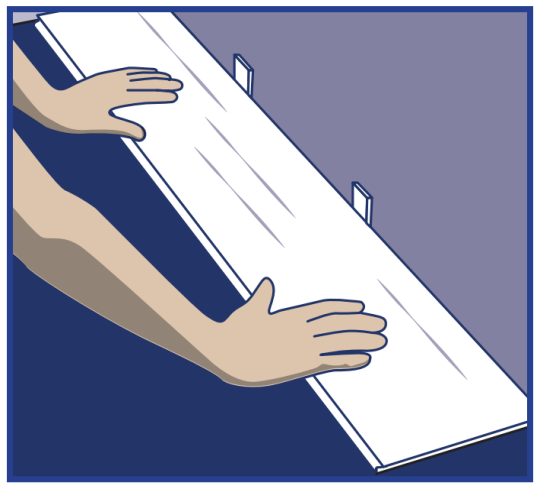
Step 1: Begin installation working from left to right. Insert spacers at ends and edges where planks meet wall to maintain ¼” expansion space |
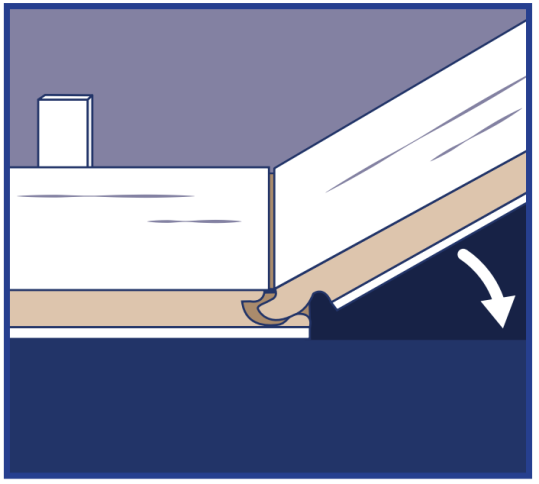
Step 2: Lock short end of plank by inserting tongue into groove at an angle and drop in place. Continue to end of first row. |
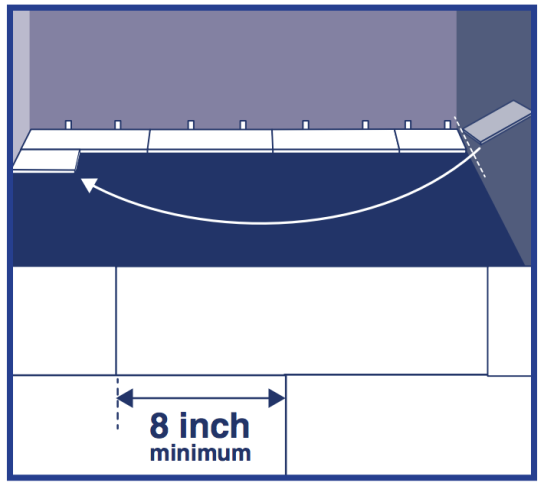
Step 3: Use leftover plank from first row as starter for second row. Minimum 8” stagger between plank end joints. |
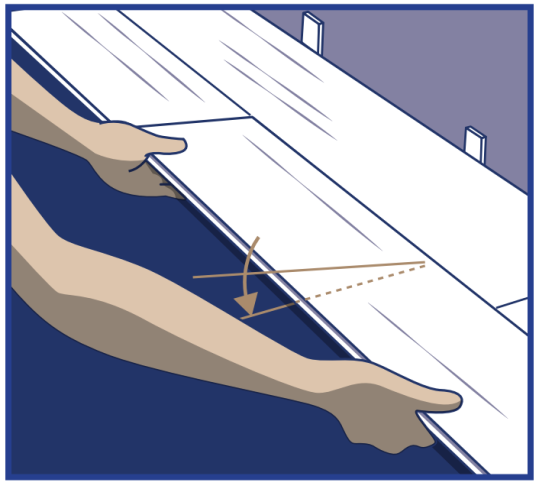
Step 4: Lock long edge of plank by inserting tongue into groove at an angle and drop in place. Slide plank toward end of previously installed plank until the tongue just touches the groove. |
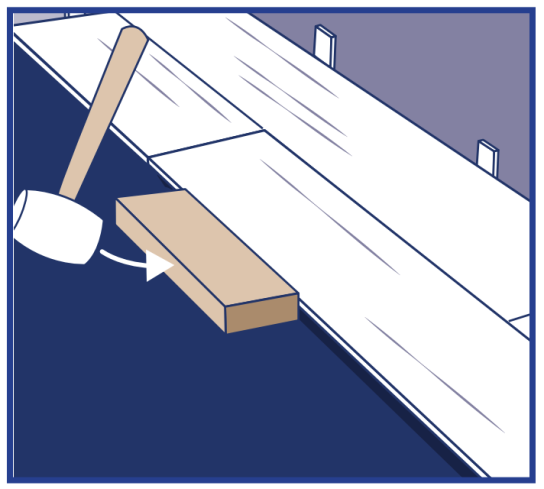
Step 5: Use hammer and tapping block to engage plank and ensure tight fit. |
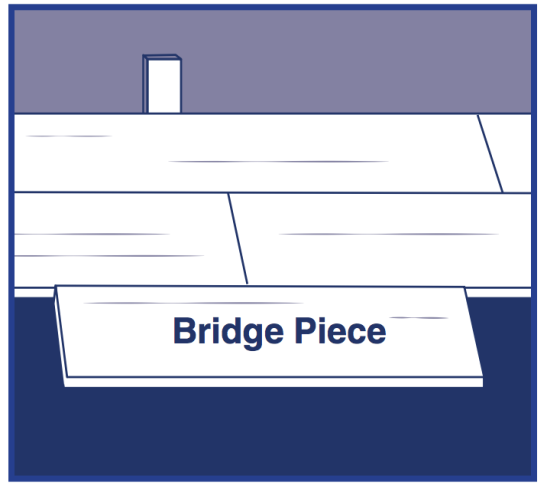
Step 6: Attach a scrap piece to align planks and bridge gaps between planks. |
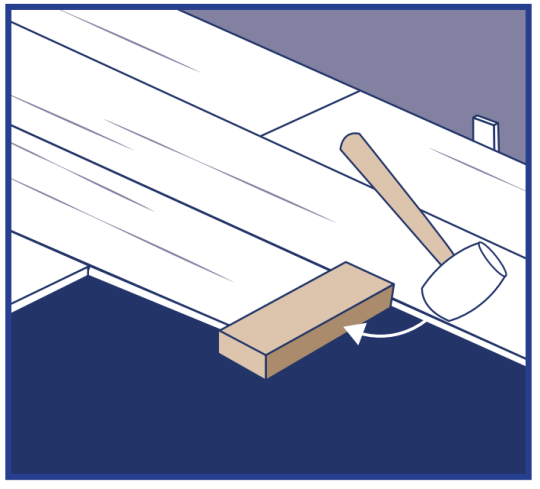
Step 7: Tap end of planks with hammer and tapping block to engage ends. |
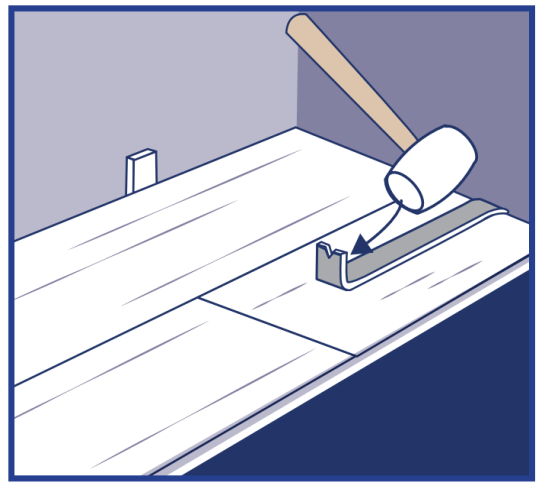
Step 8: Use hammer and pull bar to engage final piece, insert spacers and continue to next row. |
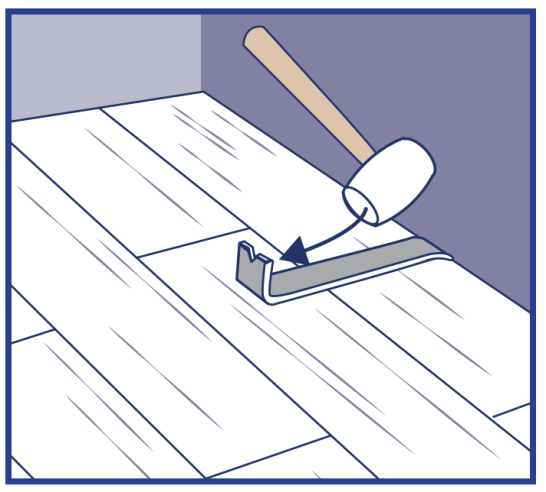
Step 9: Use hammer and pull bar to lock planks on final row. |
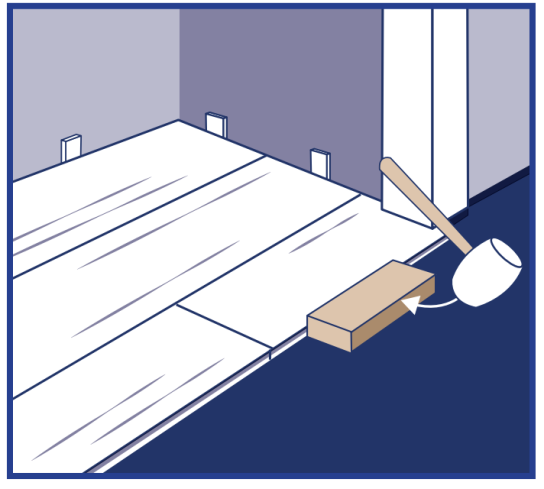
Installation under door jambs: Step 1: Undercut door jamb to allow plank to slide freely. Use a tapping block to lock planks. |
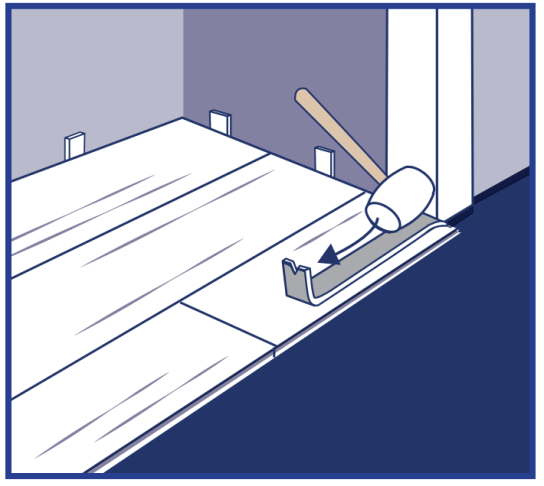
(Continued)
Step 2: Use hammer and pull bar to lock short end of plank.
Alternative Installation Technique
.jpg?width=200&height=90) 1. Gather your tools |
flat, dry and structurally sound. |
3. Measure your space |
4. Choose your starting wall |
.jpg?width=200&height=90) 5. Place tongue side in the starting corner (work from left to right). |
6. Use several spacers to maintain 1/4"expansion gap along the walls. |
7. Lock the short ends together to complete your first row. Cut the planks as needed to fit the space. |
.jpg?width=200&height=90) 8. Start your second row. With a cut-off that is more than 8" long or start with a new plank. |
.jpg?width=200&height=90) 9. Connect the length side at a slight angle, engage the long side and rotate down. |
.jpg?width=200&height=90) 10. Continue installing the row |
11. Repeat steps to finish the room |
12. Enjoy your new floor! |
-
Before you start with the installation, it is important to determine the layout of the flooring. Proper planning and layout will prevent having narrow plank widths at wall junctures or very short length pieces at the end of rows.
-
Determine if the starter row will need to be cut. If the first row of planks does not need to be trimmed in width, it will be necessary to cut off the unsupported tongue so that a clean, solid edge shows towards the wall.
-
Installation of the product must start from the left side of the room, working to the right when working in front of the planks or facing the starting wall.
-
Install the second plank in the row by angling the end tongue into the end groove of the first plank. Be careful not to bend the corner of the plank. Maintain an expansion gap of approximately ¼’’ (6.35mm) from the wall. Start the second row by cutting a plank to the desired length. Keep in mind that the plank must not be shorter than 6" (15cm) to achieve the best appearance.
-
Install the first plank in the second row by inserting the long side tongue into the groove of the plank in the first row. This is best done with a low angle of the plank. Maintain pressure into the side seam as you rotate the plank to the subfloor. Install the second plank in the second row by inserting the short end tongue into the previously installed plank groove. Once the short end is engaged, the long side will need to be lifted slightly and worked into the locked position by push/pulling the long joint of the planks together, then rotating towards the floor to fully seat. A tapping block may be used to ensure the joint is fully seated.
-
Work across the length of the room installing planks along the wall in the first row and then aligning the planks in the second row. It is critical to keep these two rows straight and square, as they are the “foundation” for the rest of the installation. Check squareness and straightness often.
-
Cut the last plank in the first row and leave an expansion gap of around ¼’’ (6.35mm). The leftover of this plank may be used to start the third row if it’s a minimum 8" (20.32 cm) long.
-
Continue installing planks and make sure to achieve a random appearance with end pieces of minimum 8" (20.32 cm). Check that all planks are fully engaged; if a slight gapping is found, the gap can be tapped together by using a tapping block and a scrap of flooring to cover the tapping block in order to avoid damages on the planks.
-
When fitting under door casings, etc., the flexibility of the locking system becomes evident. If necessary, a flat pull bar may be used to assist in locking the planks.
-
When fitting around obstacles or into irregular spaces, planks can be cut utilizing a jig saw or rotary cutting tool. It is often beneficial to make a cardboard template of the area and transfer this pattern to the plank.
- Protect all exposed edges of the flooring by installing wall molding and/or transition strips.
- For wet areas such as bathrooms caulk the perimeter of the floor with a flexible silicone caulk
- Protect the finished flooring from exposure to direct sunlight to reduce fading and thermal expansion.
- Adhering tape to the surface of your resilient flooring could damage the surface. Do not use tape to secure floor protection directly to the floor during construction or renovation. Instead, adhere tape to the material used to protect the floor and secure it to the base molding along the wall. A material such as ram board can also be used to protect your flooring.

.jpg?width=200&height=90)

